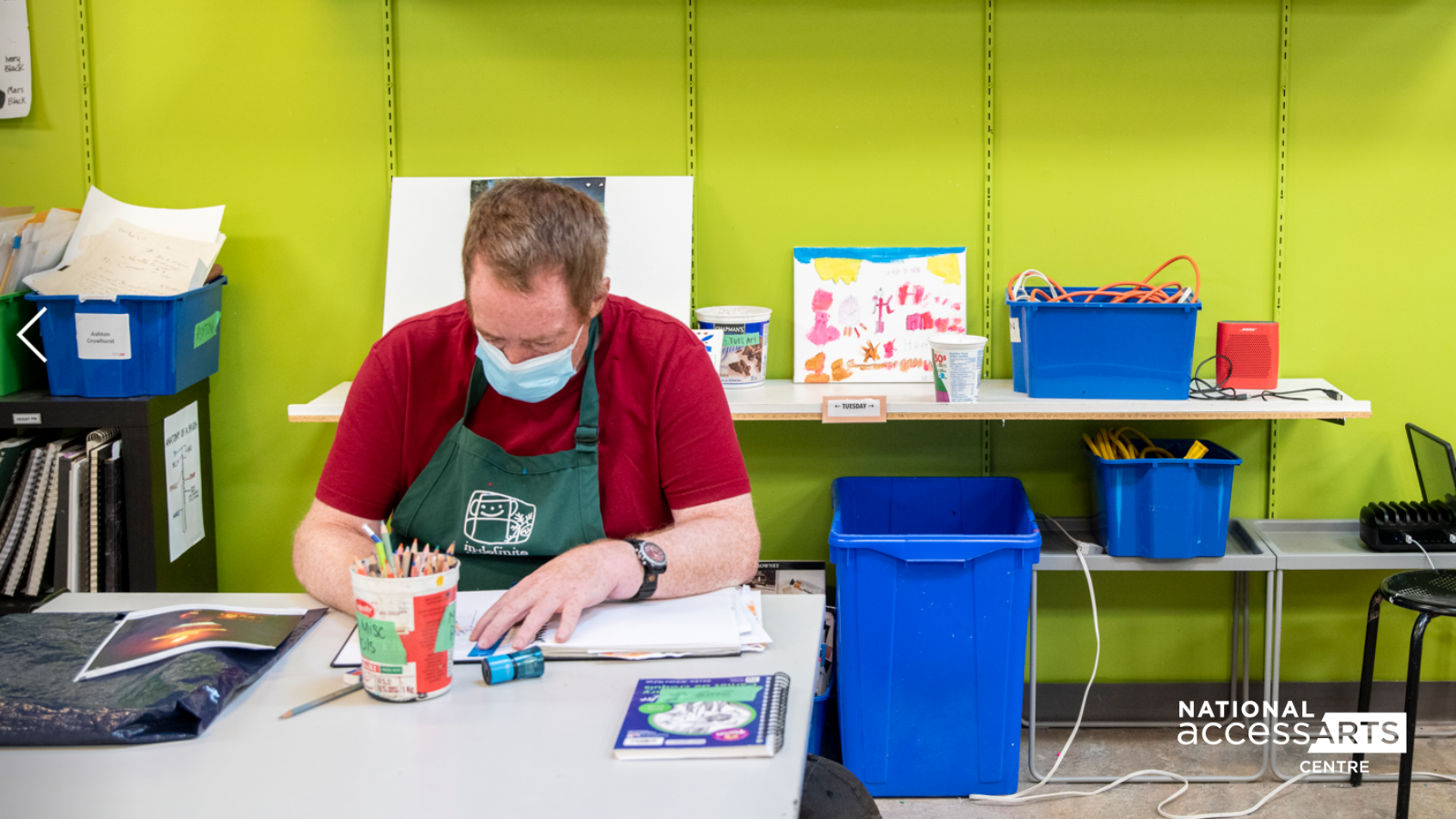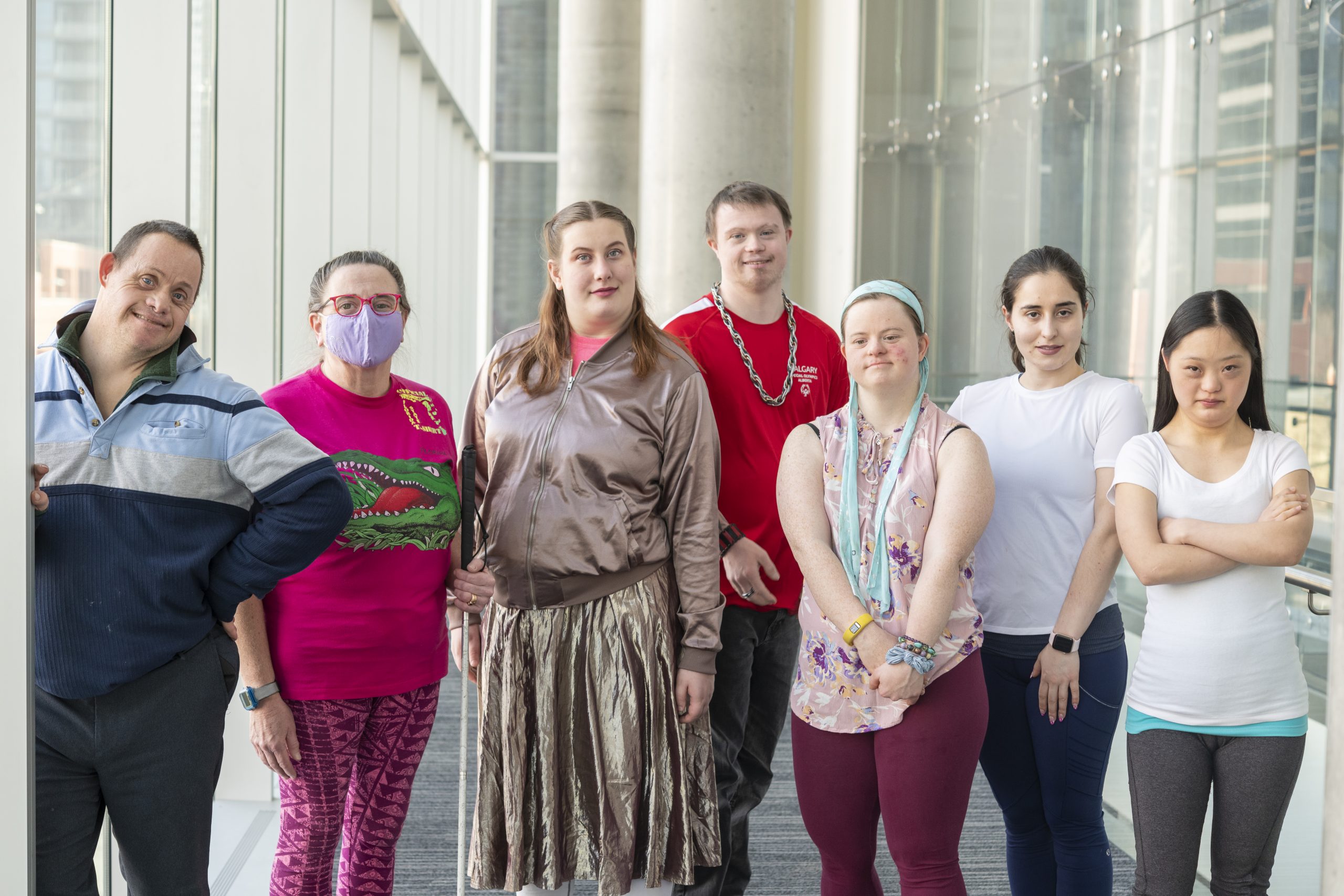Leading the conversation about accessible online learning.
When mandatory public health restrictions were lifted and most organizations returned to normal operations, the National accessArts Centre (NaAC) was left wondering why. For the 350+ artists with disabilities the centre serves, “normal” ways of working, learning, and creating haven’t always benefitted them.
So, when some artists started coming back into the studio, the NaAC maintained online sessions for those who could not yet return to in-person programming. The Artist and Program Development team saw an opportunity to fill a gap in service, not just for NaAC artists working remotely, but for all artists from the disability community with limited access to quality arts training.
“The online sessions were an important access point for folks who were at home and couldn’t get to the studio for different reasons, like a lack of support, complex medical needs, or access to transportation,” says Raewyn (Rae) Reid, Manager, Studio at the NaAC. “That social inclusion piece is really important, and we wanted to make online programming more sustainable and meaningful for our artists, but also reach more people who might be living in remote areas.”
Enhancing the Online Experience
The NaAC’s top priority was to maintain the in-person studio culture and continue to champion an individualized approach to artistic development—just in a digital space. That’s where Trish Jagger came in. Trish is a doctoral student from the Department of Secondary Education at the University of Alberta. As an advocate for creating equitable and inclusive spaces through digital storytelling, Trish was thrilled at the opportunity to work with the NaAC.
“Too many people are fixated on going backwards without actually looking at what worked before and what didn’t work before,” Trish says. “Here is a not-for-profit organization invested in not just going back to normal with their programming, but actually taking what they’d done in that online space and seeing where they could go with it to help them grow.”
With 20 years of experience in film and media production, and 10 in education, Trish is passionate about digital and media literacy—something she says is often overlooked.
“Today, young people are growing up in a society saturated with visuals,” she says. “So how are we teaching them to construct and deconstruct to think critically about those images in the same way that we teach them to think critically about the text that they read and they write?”
As a consultant with the NaAC, Trish was able to combine her passion for digital and media literacy with her experience as an educational developer to advise the team on accessible online learning—developing a model for online programming that’s taking the organization to the forefront of the artistic community.
Creating Safe and Accessible Spaces
For several weeks, Trish met one-on-one with NaAC artists to gather critical feedback about the various aspects of online programming they felt were meaningful and identify areas for improvement.
“She spent a lot of time gathering information on how people engaged with those different iterations of online programming and how they wanted to move forward,” says Rae.
In interviewing the artist community, one thing became clear: the in-person studio model cannot simply be plugged into a digital environment.
We realized that if we were going to continue moving forward and creating that access point for artists who can’t come into the studio in person, we needed to think of online programming as its own thing and not a plug-and-play model. It requires a different methodology and approach.
Rae
So, Trish provided a roadmap the NaAC could follow moving forward—a toolkit for facilitators that could be adopted and applied to any online workshop. She broke it down into four different workshop models, each with a different outcome depending on the needs and wants of the participants. Included in the toolkit are recommendations like establishing group norms and starting with check-ins and check-outs.
“A big part of any participatory space, and creating a safe space, is making sure you’re establishing norms for the group that you can constantly refer back to in that introductory opening session,” says Trish. “Because these norms are created collaboratively with the group, and everybody agrees on them, they become a touchstone for reinforcing an equitable space.”
She gives the example of cameras. “When we first started online, everybody needed to have their camera on to show that they’re present and engaged. But much like in a classroom, you start to step back and think about what you’re asking people to do. Maybe they don’t want their camera on,” she says. “They might not show up the way you want them to show up, or were expecting them to show up, but they showed up.”
With the toolkit in place, Trish worked with the Artist and Program Development team to design a test curriculum they could deliver online in real time: a 14-week program exploring techniques in mixed media and collage.
“The artists will be working through a curriculum with different prompts and demonstrations,” says Rae. For the first five weeks, the facilitators will demonstrate a new skill every day using video. “That way, if somebody needs a little bit more time to work on a skill, they’ll have something that they can return to,” they add.
Then, the artists will be given time to blend techniques together and experiment with different mediums.
Finally, they’ll prepare their work for presentation.
Signaling Change
For Trish, seeing the first program launch is encouraging. Her hope is that the facilitators find comfort with the toolkit, and that it gives them a strong starting point to build more online programs and expand their reach.
“If anyone can do it, it’s the Artist and Program Development team at the NaAC,” she says. “They are brave. They’re already involved in the conversation [about online programming], and their response as we came out of the pandemic was not to say, ‘let’s go back to normal’ but ‘let’s look for the opportunity.’ And that alone makes the NaAC the right organization to be doing this work.”
The reality is that the online world is not going away, Trish adds.
“We’ve opened Pandora’s Box; we’ve handed it to kids in the form of cell phones and iPads and computers. And if we’re not brave enough to tackle it now, then the issues that we’re seeing at this moment in time are going to only get worse,” she says. “The NaAC is taking a leading role in showing what safe online learning spaces can be, and helping their artists become more critical about how, and with whom, they engage on the internet.”




